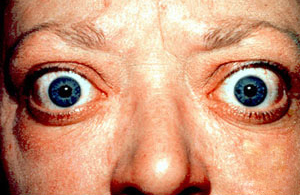Thyroid Eye Disease (TED) Symptoms and Treatment
Sometimes called Graves' eye, thyroid eye disease (TED) is an autoimmune response targeting the back of the eye, damaging the eye muscles. The first signs are redness, swelling, dry eyes, and pain behind the eyes. Over time, the swelling becomes more pronounced, creating the illusion of staring or bulging eyes.
When thyroid eye disease is caught early, there is a higher chance symptoms can be eased and eventually reversed. Left untreated, the disease may lead to chronic pain, vision complications, or even blindness. It's important to identify symptoms early and meet with an opthamologist to build a treatment regimen that works for you.
Risk Factors of Thyroid Eye Disease
TED is associated with an overactive thyroid, aka Graves' disease, leading some to call it Graves' eye. Smoking increases the chances of developing TED, and heavier smoking is associated with more severe symptoms.
Signs and Symptoms

- Inflammation of the eyes and eyelids
- Redness and swelling (but usually no itchiness)
- Pain in or behind the eyes that worsens when looking at the edges of your vision
- Dry eyes
- Watery eyes
- Appearance of staring or bulging eyes
- Strabismus (misaligned eyes)
- Blurred Vision
- Double vision
- Difficulty moving one or both eyes
Don't Have an Overactive Thyroid?
A healthy thyroid does not rule out thyroid eye disease. Thyroid eye disease is often caused by an overactive thyroid, but the two may occur independent of each other.
While an overactive thyroid may lead to TED, an underactive thyroid causes the same symptoms. If an underactive thyroid is treated, the associated symptoms typically improve on their own.
Early Treatment Options
As an autoimmune disease, TED sometimes gets worse before it gets better. There is a variety of treatments to reduce and alleviate symptoms and keep the eyes healthy while the disease runs its course. However, surgery is not recommended until the disease has become stable.
Universal TED Treatment
Vitamin E, aka selenium, is your best defense against thyroid eye disease. The recommended dosage is 100 micrograms per day. You can also supplement your diet with nuts and leafy greens. Sunflower seeds and almonds are especially rich in vitamin E.
A healthy diet helps greatly against an overactive thyroid, which, in turn, may ease the symptoms of TED.
Most importantly, if you smoke, it's vital to stop or cut down on smoking in order to mitigate symptoms.
Treatment for Dry Eyes
There are several quality options to keep the eyes moist through the course of TED:
- Artificial tears
- Nighttime ointment
- Gels
- Topical steroids (loteprednol, fluorometholone)
A persistent regiment of one or several dry eye treatments will alleviate the worst of the symptoms. See more information on dry eye treatment.
Congestion Relief
Thyroid eye disease causes congestion to build within the eye. Most often, this only causes discomfort, but more severe cases may lead to blindness. Staying on top of congestion will not only improve day-to-day comfort, it will help to avoid the need for emergency surgery.
Congestion is treated with oral or intravenous steroids. Monthly injections are recommended in order to target the area directly and keep side effects at a minimum. While steroids help significantly against congestion, they can be harsh on the body, sometimes leading to liver failure, diabetes, insomnia, psychological changes, and other complications. Discuss the benefits and risks with your doctor before starting treatment.
Strabismus Care
TED sometimes causes eye misalignment, which leads to blurry or double vision. Low-dosage radiation treatment is recommended to prevent further damage to the eye muscles while TED runs its course. Treatment is typically performed in 10 sessions over 2 weeks. The radiation dosage is not enough to damage the optic nerve but may cause dry eyes.
Treatment Options in TED Stable Phase
After the auto-immune response has run its course, it's safe to consider surgical remedies. Your opthamologist may recommend one or more surgeries to make a full recovery.
Orbital Decompression
The most common thyroid eye disease surgery relieves the congestion that builds in the eye, greatly reducing eye aches. It also treats more severe symptoms such as corneal exposure and risk of blindness from optic nerve damage.
The out-patient procedure takes 60-90 minutes and is performed under anesthesia. The blockage is relieved using microscopic incisions. There are rare cases of scarring and double vision, and even rarer cases of blindness as a result of the surgery. Most patients are very happy with the result.
Strabismus Surgery
When the eyes become misaligned due to thyroid eye disease, it's important for any alteration to be performed by a surgeon versed in TED. The eye muscles may be tender and fragile, and require special care.
Strabismus corrective surgery is performed under sedation or general anesthesia, taking 30-60 minutes. The results vary depending on the level of muscle scarring.
Eyelid Retraction Surgery
The eyelid sometimes gets caught under the eye in the course of TED, making it difficult or impossible to close. Eyelid retraction surgery eases the eyelid back into alignment. Eyelids are loose, flexible muscles and it may be difficult to recover their natural shape. However, modern instruments and techniques can help greatly to create a symmetric look.
Cosmetic Surgery
The skin around the eye often changes shape as a result of TED. Fat builds in the eyebrows and lower eyelids, and other changes may occur to the face and neck. See the full article on blepharoplasty.
As an autoimmune disease, there is no simple solution to thyroid eye disease. However, its effects can be mitigated and its symptoms alleviated with time and patience. The most important step is to act early. Please contact us if you believe you or a loved one may have TED.
